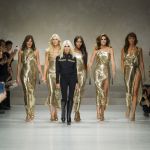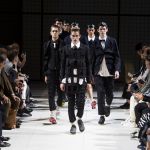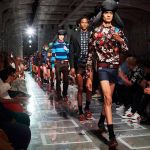
Nostalgia and Millenials on the Milan's runways
From Versace to No. 21 the collections look back to the '90s, but why?

September 26th, 2017
Milan Women's Fashion Week SS18.
Dolce & Gabbana bring catwalk style that made them famous in the world, made of corset dresses, lace, heads of transparent chiffon that leave visible panties and bra, skirt bustier, black broken by a polyphony of prints that evoke Sicily. Missoni celebrates 65 years of experience, one after the other, the codes that have characterized the brand so far, from color contrasts to rows, from knitwear to geometric prints. Alessandro Dell’Acqua proposes for N°21 the collection designed for SS97. Donatella Versace celebrates Cindy Crawford, Carla Bruni, Naomi Campbell, Claudia Schiffer and Helena Christensen, 5 iconic top 90s models for the tribute to the beloved brother Gianni and the dresses he created at the beginning of that decade: Vogue , Warhol, My Friend Elton, Icons, Baroque, Animalia, Native Americans, Tresor de la Mer, Metal Mesh, Butterflies.
Why do so many designers choose to go back to the past to dress the future?
Because they are the guys, the Millennials, that asks for it.
They are, totally unconnected with the déjà-vu danger, undergoing a hypnotic fascination with what is linked to yesterday, with a particular weakness towards the nineties. What for others is a tribute, quotation or worse copy, is to their eyes new, fresh, desirable. With Millennials, nostalgia turns into a suggestion to revive, in a source to draw for shaping the present, which carries with it a desire and an idealized memory but, for such a technological generation, is it not a contradiction to look so enthusiastic about the past?
Paradoxically, being constantly immersed in technology offers this generation tools and easy access to a virtual album of memories from which to take inspiration and ideas. From this perspective, the hashtag #ThrowMeBack or #ThrowBackTime, so popular on Instagram and co., goes beyond the limits of a mere return to a past moment, to become an active archeology, not too dissimilar to the vintage and heterogeneous mood leading the style of Alessandro Michele and the new era of Gucci (it is no coincidence that Marco Bizzarri, president and CEO of Gucci, stated that 50% of the Florentine brand business now comes from Millennials).
The imagination of Millennials is fast, distracted, overloaded with knowledge and information, but still able to get excited about a detail, a product, an advertisement, to the point of being able to create real tendencies that move not only the contemporary taste but also consumption. And it is precisely on this effect that nostalgia has on the millennials that many brands' marketingprofessionals have realized how important is to target.
What does the repurposing, even if it is adapted to the contemporary, of what has already been experienced in the past is the new trend, intended to last, even for the fashion world?






















































